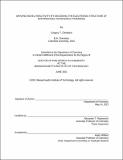DRIVING NOVEL REACTIVITY BY DECODING THE ELECTRONIC STRUCTURE OF NONTRIGONAL PHOSPHORUS TRIAMIDES
Author(s)
Cleveland, Gregory T.
DownloadThesis PDF (8.577Mb)
Advisor
Radosvich, Alexander T.
Terms of use
Metadata
Show full item recordAbstract
Trivalent phosphorus compounds are ubiquitous throughout synthesis, with applications ranging from ligands in transition metal chemistry to mediating organic transformations. Their reactivity is canonically regarded as nucleophilic by virtue of the electronic structure governed by their three-fold symmetry. Geometric distortion away from a C₃ᵥ symmetric structure drives stabilization of a phosphorus-based acceptor orbital, enabling electrophilic reactivity. Leveraging this electrophilicity, nontrigonal phosphorus compounds elicit a host of novel chemical transformations. While the impact of these new chemistries is unquestionable, there still lacks fundamental understanding regarding these novel compounds. Herein are described efforts to drive future novel reactivity by garnering a more basic understanding of the impact of geometric distortion.
First, ³¹P solid-state NMR spectroscopy is utilized to probe the frontier electronic structure of nontrigonal phosphorus triamides in comparison to trigonal analogues. This provides the first known analysis of the pairwise frontier orbitals that govern biphilic reactivity and offers a routine and facile method by which to analyze future compounds. Next, the properties of nontrigonal phosphorus compounds as ligands for transition metals is investigated, showing an increasing in π-backbonding that occurs upon geometric distortion. The electrophilicity of the phosphorus center is leveraged to generate a stable metallophosphorane by nucleophilic attack of exogenous fluoride, offering potential for nonspectator ligand behavior. Finally, a suite of nontrigonal phosphorus triamides featuring varying substituents in the ligand scaffold is prepared, showing that the reactivity of this class of compounds can be further modulated by electronic effects beyond that of the initial geometric deformation.
Date issued
2021-06Department
Massachusetts Institute of Technology. Department of ChemistryPublisher
Massachusetts Institute of Technology